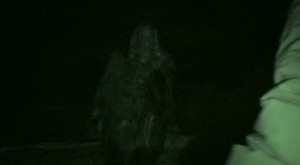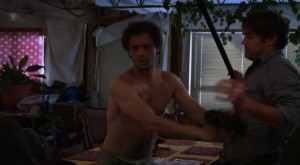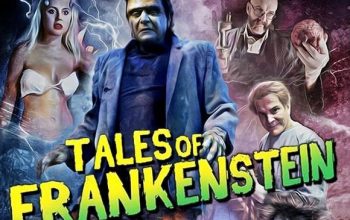The Frankenstein Theory – 2013
Life and death appeared to me ideal bounds, which I should first break through, and pour a torrent of light into our dark world. A new species would bless me as its creator and source; many happy and excellent natures would owe their being to me. No father could claim the gratitude of his child so completely as I should deserve theirs. – Mary Shelley, Frankenstein
Don’t fuck with the forces of Nature. You’ve got to respect her, because Nature doesn’t forgive. – Carl, The Frankenstein Theory

I’m saying that Mary Shelley’s novel, Frankenstein, is a work of non-fiction. I’m saying it’s a work of non-fiction disguised as fiction, or more accurately it’s a fictionalisation of one of the most incredible true events in human history. – Jonathan Venkenheim, The Frankenstein Theory.
I’ve mostly been looking at older Frankenstein movies, for the simple reason that there are more old Frankenstein movies than new ones. This is not to say that they’ve stopped making Frankenstein movies altogether, just that the pace has slowed. One day I’ll get around to I, Frankenstein, possibly after drinking heavily, and I’ll certainly see Victor Frankenstein when it’s released. But right now, I’m going to have a look at a little indie horror film from 2013, The Frankenstein Theory.
The Frankenstein Theory is one of the more recent iterations on the idea of Frankenstein. It’s something of a mixed bag. Parts of it are excellent. The premise is interesting and there are some genuinely tense scenes. Other parts… look, I’m not going to lie: this is a found footage movie.
Found footage movies. Okay, lets go back a step before we talk about them. Most horror movies are cheap. Sure, there are big budget, major cinema horror movies. Lots of them. But the average horror movie is a cheapie. The financial equation behind them seems to be low budget times mediocre box office = profit, and it’s an equation that’s worked. From pre-war cinema to the drive-ins of the ’50s to the ’70s to direct to VCR, to direct to DVD, to Netflix and Hulu, the cheap horror film has flourished in the shadow of the big-end of the film industry.
But what if… what if instead of low budget x mediocre box office you managed low budget x good box office? This happens from time to time – Night of the Living Dead for example or Halloween – and when it happens dozens of other indie horror filmmakers leap forward to put out their own versions of the successful film. After all, if that goose laid a golden egg one time, why not kill it?
The Blair Witch Project is a great example of this trend. The conceit was that a group of student filmmakers went to investigate an urban legend, then weird scary stuff happened and they disappeared. The film is supposedly edited from the footage that they took. It was an innovative way to make a horror movie for nothing, and the publicity campaign which suggested that the footage was real helped make it a huge international box office success.

Trouble is, in retrospect, it’s not very good. I mean, Blair Witch has some effective sequences, but mostly it’s three people you’d happily cross the street to avoid talking to, but wandering lost in a forest. Mainstream cinema release is how it made its money, but it also cripples it as a picture. With tighter editing and a forty-five minute run time, it might have been awesome, but as it is it comes across bloated and padded. And when a film in which little happens seems padded, something has gone wrong.
But I’m digressing far too much. Blair Witch spawned a slew of ‘found footage’ horror movies, few of which achieved Blair Witch’s commercial success. The Frankenstein Theory certainly didn’t, though it’s one of the better ones that I’ve seen.
In The Frankenstein Theory, Johnathan Venkenheim (Chris Lemche) is a brilliant young scientist/historian, but his career is hitting difficulties because of his weird theory, namely that Frankenstein is a true story. His distant ancestor, he says, was Johan Venkenheim,a scientist working for the Illuminati (!). Johan discovered genetic theory a century early and used this knowledge to create a monster. He encountered the Arctic explorer Captain Walton, who wrote of Johann in letters to his sister. These letters were adapted by Mary Shelley into her novel.

Jonathan, a twitchy obsessive, pretentious sort of fellow, has been unable to prove any of this. He decides to prove his point by finding the monster, who he believes is alive and well in the Arctic circle. Having gathered data on caribou migration and missing persons in Northern Canada, he believes that he can pinpoint the Monster’s location. He hires a film crew (Heather Stephens, Eric Zuckerman and Brian Henderson) to come with him, and this film crew provides the found footage.
Jonathan and his crew go to Canada. Jonathan has a sketch of the Monster, introduced in evidence during the trial of Justine for the murder of William. He shows it to an eyewitness, who claims to have seen the creature, but as a severe meth addict, his testimony is questionable.
Karl (Timothy V. Murphy), a crusty, Captain Quinn-like guide takes Jonathan and the crew up north. The camera crew become scared and argumentative, but Jonathan manages to keep them in line. One by one they are picked off by some unseen (but often heard) presence. In the end, Venkenheim comes face to face with the thing, which certainly seems to be the Monster.

I’m in two minds about spoiling the ending. Most of the films I’ve looked at so far are decades old, but this one is kind of recent. Hm… Okay spoiler: there are two obvious endings for this movie. The film chooses one of them. It is not satisfying.
This is a pity. The middle of the film is actually quite atmospheric. It borrows quite a lot from Jaws – a bunch of isolated people hunting for a monster, with the help of an unnecessarily gruff outdoorsman type. The acting isn’t mindblowing, but it’s competent. The reactions of people to what Venkenheim says is quite well done. The makers learned the mistake of Blair Witch and have a great deal more incident in the course of the movie. The tense encounter with the gun-toting meth-head is scary and awkward at the same time.
The location filming is also pretty good. The stark whiteness of the snow makes for unique visuals compared with the murkiness of most low budget shockers. The conceit that there are two camera crews makes for a more interesting setup than many found footage films. (Remember Cloverfield? Why didn’t that guy just drop the camera when the monsters were coming? Why?) It also avoids the pacing problems of Blair Witch by keeping up the rate at which incidents happen, rather than saving all the punch for the end.
So these are Theory’s interesting points as a movie. I don’t want to damn it with faint praise, but for a low budget indie horror movie it’s actually pretty good. But how is it as a Frankenstein movie? Here, we’re on thinner ice. The parts of the film that work well – the isolation, the wilderness, the predator outside – could work just as well if Vankenheim were searching for Bigfoot or the Yeti. You could be excused for thinking that the Frankenstein Monster is there to give a little colour to the movie, rather than for the movie existing to say something about Frankenstein.
In spite of that, it does say something interesting about Frankenstein. It changes the story incredibly. Frankenstein is a Romantic era writer’s idea of how science works, which is about as unrealistically individualistic as the Romantic conception of how art works. Unlike most scientific progress, which is the result of the collegiate work of multitudes of people, Frankenstein comes up with the greatest single discovery in the history of science all by himself. He makes a living creature without help from anyone. The entire literary trope of the Mad Scientist descends from Mary Shelley’s conceit. In making Johann Venkenheim the head of a research group rather than an isolated eccentric, it alters the story’s connection to the actual working science.

Another point is the character of the Monster. The sympathy that Frankenstein movies so often show for the Monster is not to be seen. In this movie, it has been alive for hundreds of years, alone in the Arctic wilderness, living by hunting and killing anyone who comes too close. While Venkenheim would like to believe that the Monster retains some of its humanity, little is on show.
The other interesting thing – and honestly, I didn’t pick this until the second time I watched – is that it doesn’t retell Frankenstein’s story, so much as Captain Walton’s. In the novel, Captain Walton is on an Arctic expedition with a scared and somewhat mutinous crew, which is pretty much the situation that Jonathan Venkenheim finds himself in here.
There is such a jarring disconnection between the framing story of the novel Frankenstein and the main story. I’m inclined to believe that the integration of the two narratives is the most interesting thing Theory brings to the table.



